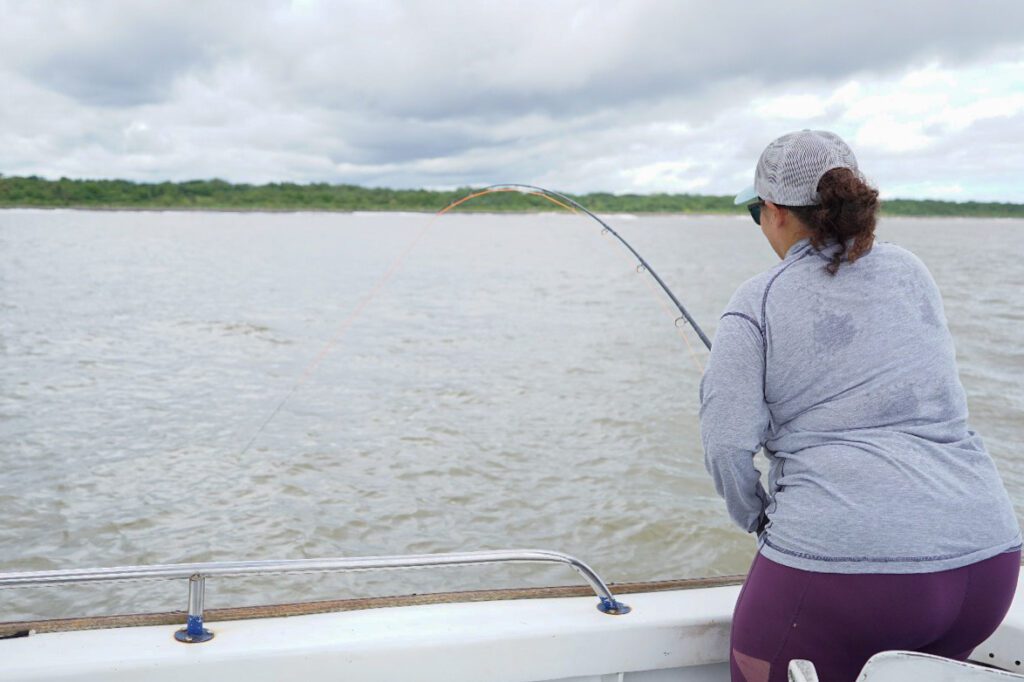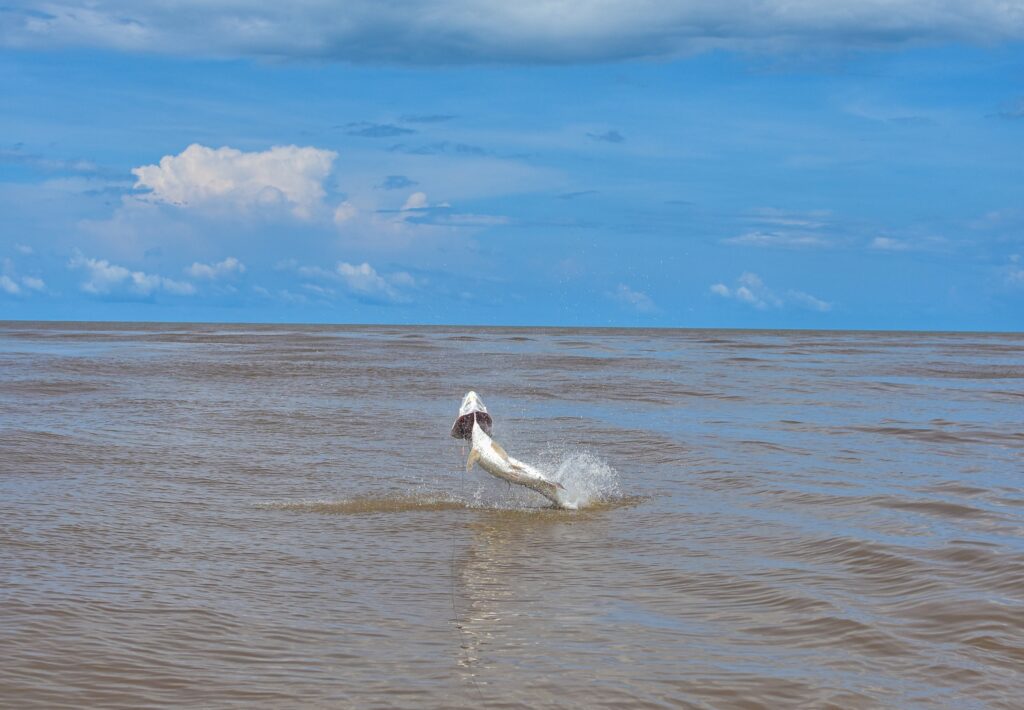Costa Rica’s Northern Caribbean Coast has a long history of sportfishing lodges dedicated to giant tarpon and snook: Rio Parismina, Casa Mar and Rio Colorado. Founder and Guide Peter Gorinsky helped to teach many of the local tarpon guides to fly fish here in the 1970s.
Few realize, however, that the area also offers some of the country’s best tropical panfishing, for colorful and exciting fish like the guapote (rainbow bass), guapote pinto, mojarra (tropical sunfish) and machaca. Snook and tarpon are also on offer here — and a calm day at sea can make for some of the most exciting fly fishing for giant tarpon you can image. We use local boatmen and stay in simple, but clean local accomodations near the sea with good food and easy access to the fishing.
The North Caribbean coast of Costa Rica is a prime destination for tarpon fishing, with these incredible fish available year-round thanks to the region’s tropical climate and rich waters. However, there are two main “peak” seasons that offer ideal conditions for catching tarpon, depending on what kind of fishing experience you’re looking for.
The first peak season typically runs from April through May, a time when weather conditions are drier and the water is generally calmer. This makes it easier for anglers of all levels to enjoy smooth fishing conditions. During this time, tarpons can be found closer to the surface, making them more accessible for fly fishing.
The second peak season occurs between September and early November, just before the rainy season reaches its peak. During this period, tarpons are highly active and can be found in large schools near the river mouths and estuaries along the coast. Although some days might experience light rain, this season is perfect for anglers who enjoy a more challenging experience with exciting bites.
Outside of the two main peak seasons, tarpon fishing is still excellent. You can expect fewer tourists and calmer fishing spots, especially from May to August. While rains are more common, they bring nutrients into the rivers, attracting even more fish species and making it possible to catch not only tarpon but also tropical panfish and other species unique to the region.
The North Caribbean of Costa Rica is known for its giant tarpon, with these powerful fish averaging between 100-250 lbs. Our tour provides everything you need for tarpon fishing, including heavy-duty 12-14 wt rods, sinking lines, custom-tied leaders, and durable flies on robust hooks. We supply all terminal tackle and fishing equipment; clients can use our professional-grade rods and reels or bring their own gear if they prefer.
For a full fishing adventure, we recommend a four-day tour. This allows for two full days dedicated to battling the giant tarpon, with the option to spend an additional day or two fishing for Costa Rica’s unique tropical panfish species. Panfish, such as the colorful guapote, are best caught with lighter 3-7 wt rods along the jungle’s edge, requiring floating lines for an exciting close-to-shore experience. Choosing this extended tour allows anglers to hedge against weather changes and fully enjoy both tarpon and panfish fishing, adding variety and thrill to their fishing adventure.

These are all wild tropical fish, and the success of your catch will largely depend on your angling skills. We highly recommend that you practice with the rod, reel, and line you plan to use before your visit. Focus on target casting, as you may only get one chance to catch a fish. In many locations, we will be casting into pockets among the foliage where fish are hiding, making accuracy crucial. Your experience and skill level will play a significant role in your fishing success.
The fishing tour lasts approximately 8 to 9 hours, depending on weather conditions. We start at 6 a.m. and fish until 11 a.m., when we take a break for lunch and give clients a chance to rest. We then resume fishing at 1 p.m. and continue until 5 p.m., making it a full day with exciting fishing opportunities.
You don’t need to be an expert in this location, but having prior knowledge and some fishing experience is recommended. This will help you enjoy the experience more, as our trips include specific fishing techniques in tropical environments that may require casting precision and familiarity with the equipment. While our guide will be by your side to provide support and instructions, having a foundation in fishing is useful to maximize your chances of success and make the most of the day.
The tour can be private or shared. To book a private tour, a minimum of 2 anglers is required. If there is only one angler, the tour will be shared if there are other solo anglers who wish to book for the same day.
Drive times vary greatly in Costa Rica depending on traffic, weather, and road conditions. We ask for your understanding. From San José, where the airport is located, to the north-central tarpon rivers and lagoons is approximately 2.5 hours.
To ensure a comfortable and safe experience during our fishing tour in Costa Rica, we recommend wearing lightweight, quick-drying clothing due to the region's climate changes. It’s essential to include a hat and sunglasses to protect yourself from the sun, as well as sunscreen and insect repellent. We also suggest bringing a waterproof bag and a lightweight rain jacket, just in case.
For footwear, sandals, athletic shoes, and sneakers are recommended so you can fully enjoy your day on the water. We are confident that with this gear, you’ll be ready for an unforgettable adventure!
In this area, internet coverage is limited and can vary in efficiency. This means that, at times, you may not have access to a stable connection. However, at the hotel where you are staying, you will be able to enjoy a more reliable internet service, allowing you to stay connected during your stay
For non-angling companions, the lodge provides an excellent opportunity to enjoy nature. They can relax and observe a wide variety of wildlife in its natural setting, from exotic birds to other animals native to the area. Additionally, the lodge has a beautiful pier, perfect for taking in breathtaking sunsets and offering a tranquil atmosphere with unforgettable scenery

In our fishing tours, we make sure you have a memorable and complete experience. We provide refreshments and snacks to keep you energized throughout the day. You’ll have an experienced guide who will give you expert instructions, ensuring you learn the best fly fishing techniques.
We provide all the fishing equipment (rods, reels, and flies), but you are welcome to bring your own fishing gear.
It’s important to note that we do not provide lunch, alcoholic beverages, or gratuities as part of the tour. We also ask that clients cover their own transportation expenses, including car rental and fuel. However, we can arrange transportation for you at an additional cost if desired.
We offer all-inclusive packages so you can enjoy a worry-free experience in the Northern Caribbean of Costa Rica. This lodge is the perfect destination for nature lovers and tarpon fishing enthusiasts, set in a stunning natural environment and accessible only by boat.
The rooms are fully equipped with air conditioning, hot water, and all the necessary amenities to ensure a comfortable stay. Additionally, you can savor delicious local cuisine with an authentic Caribbean touch, prepared with fresh ingredients and traditional flavors.
The lodge’s privileged location allows you to disconnect from the world and immerse yourself in the tranquility of nature, with breathtaking views and unforgettable sunsets from the dock. Besides tarpon fishing, you can enjoy activities such as nature tours, hiking, and bird and wildlife watching.
Ask about our all-inclusive packages and let us create a unique experience for you!
Understanding tarpon behavior can make all the difference in your fishing success. With our guided tours in the Northern Caribbean of Costa Rica, we take you to the best fishing spots and teach you the most effective strategies to land this incredible fish.
Tarpon are opportunistic predators with a varied diet, including small fish like mullet and crustaceans. With our deep knowledge of their feeding patterns and the times of day they are most active, we maximize your chances of a successful catch.
Tarpon spawn in deeper waters, typically during new moon phases. They can live up to 50 years and reach impressive sizes, making them an exciting and sustainable target for sport fishing.
We promote responsible fishing practices to protect the ecosystem and ensure the preservation of this incredible species. Our tours strictly follow catch-and-release techniques and adhere to local regulations to maintain healthy tarpon populations for future generations.
With the stunning beauty of the Northern Caribbean, diverse fishing environments, and the thrill of battling a giant tarpon, now is the perfect time to plan your fishing adventure. Booking one of our guided tours gives you the opportunity to learn from local experts who know these waters inside and out. Whether you’re seeking the adrenaline rush of fighting a tarpon or simply enjoying the serenity of the surroundings, we guarantee an unforgettable experience.
Book your tour with us today and get ready for the ultimate tarpon fishing adventure in Costa Rica!
A Fly Fishing Adventure to Remember: Tarpon in Caño Negro...
A Beginner’s Guide to Jungle Fly Fishing in Costa Rica...
Costa Rica stands as a premier destination for anglers, especially...
Book your spot now and enjoy special promotional pricing on our guided fishing tours.